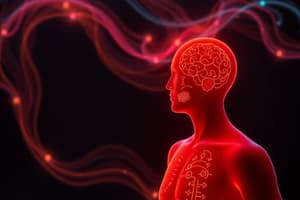Podcast
Questions and Answers
What hormone does the pancreas release to promote glucose uptake by cells when blood glucose levels rise?
What hormone does the pancreas release to promote glucose uptake by cells when blood glucose levels rise?
Insulin
Which hormone stimulates glycogenolysis and gluconeogenesis when blood glucose levels drop?
Which hormone stimulates glycogenolysis and gluconeogenesis when blood glucose levels drop?
Glucagon
What is the role of cortisol in the hypothalamic-pituitary-adrenal (HPA) axis negative feedback loop?
What is the role of cortisol in the hypothalamic-pituitary-adrenal (HPA) axis negative feedback loop?
Cortisol inhibits CRH and ACTH production
Which part of the body serves as the primary temperature regulator in mammals?
Which part of the body serves as the primary temperature regulator in mammals?
What mechanism helps cool the body by producing sweat that evaporates from the skin?
What mechanism helps cool the body by producing sweat that evaporates from the skin?
What happens to blood vessels near the body's surface when body temperature rises?
What happens to blood vessels near the body's surface when body temperature rises?
What is homeostasis?
What is homeostasis?
Explain negative feedback mechanisms.
Explain negative feedback mechanisms.
How do negative feedback loops operate?
How do negative feedback loops operate?
Why are negative feedback loops important for homeostasis?
Why are negative feedback loops important for homeostasis?
Give an example of a negative feedback loop related to body temperature regulation.
Give an example of a negative feedback loop related to body temperature regulation.
How do thermoreceptors contribute to body temperature regulation?
How do thermoreceptors contribute to body temperature regulation?
Study Notes
Negative Feedback Mechanisms in Homeostasis
Homeostasis is the body's remarkable ability to maintain a stable internal environment despite fluctuations in the external world. Negative feedback mechanisms are essential for this process, enabling our bodies to regulate various physiological processes in response to changing conditions. This article delves into the fundamental principles of negative feedback mechanisms, their role in homeostasis, hormone control, and the specific example of body temperature regulation.
The Basics of Negative Feedback Mechanisms
Negative feedback mechanisms are self-correcting systems that operate in a way that counteracts changes in a particular condition by generating an opposite response. In a negative feedback loop, the output or response is used to modify the input or stimulus, leading to a return to the original state of homeostasis.
Negative Feedback in Homeostasis
Negative feedback loops are the backbone of homeostasis because they enable the body to maintain stability. These mechanisms constantly monitor and adjust various physiological processes to ensure that the body's internal environment remains within an optimal range. Examples of negative feedback loops include:
- Body temperature: When body temperature rises, thermoreceptors in the skin and hypothalamus detect the change, which in turn signals the body to initiate cooling mechanisms such as sweating, vasodilation, and increasing breathing rate.
- Blood glucose levels: When blood glucose levels rise, the pancreas produces insulin, which promotes glucose uptake by cells. Conversely, when blood glucose levels drop, the pancreas releases glucagon to stimulate glycogenolysis and gluconeogenesis.
- Blood pressure: When blood pressure rises, the brainstem detects the change and signals the cardiovascular system to decrease blood pressure through mechanisms such as increased heart rate and decreased vascular resistance.
Negative Feedback in Regulation and Hormone Control
Negative feedback mechanisms play a crucial role in hormone regulation, ensuring that hormone levels are maintained within the body's optimal range. Hormone production is tightly regulated by the hypothalamus and pituitary gland, which coordinate the release of hormones through negative feedback loops.
For example, in the hypothalamic-pituitary-adrenal (HPA) axis, the hypothalamus releases corticotropin-releasing hormone (CRH) in response to stress, which in turn stimulates the pituitary gland to produce adrenocorticotropic hormone (ACTH). ACTH then triggers the adrenal glands to release cortisol. The negative feedback loop in this process is that cortisol inhibits CRH and ACTH production, ultimately returning the system to a state of balance.
Body Temperature Regulation
As mentioned earlier, body temperature regulation is an essential negative feedback mechanism that maintains the body's internal temperature within a narrow range. In mammals, the hypothalamus serves as the primary temperature regulator, constantly monitoring the body's temperature and initiating appropriate responses to maintain homeostasis.
Body temperature is regulated through several mechanisms, including:
- Vasodilation and vasoconstriction: When body temperature rises, blood vessels near the body's surface dilate to increase heat dissipation. Conversely, when body temperature falls, blood vessels constrict to retain warmth.
- Sweating: Sweat glands produce sweat, which cools the body when it evaporates from the skin.
- Shivering: Muscle contractions produce heat to raise the body's temperature when it falls.
Conclusion
Negative feedback mechanisms are essential in maintaining homeostasis, regulating physiological processes, and controlling hormone levels within the body. These mechanisms help ensure that the body's internal environment remains within optimal parameters, enabling us to adapt and thrive under varying conditions. Understanding negative feedback mechanisms is crucial for understanding how the body maintains equilibrium and responds to changes in its environment.
Studying That Suits You
Use AI to generate personalized quizzes and flashcards to suit your learning preferences.
Description
Explore the fundamental principles of negative feedback mechanisms, their role in maintaining homeostasis, hormone regulation, and the specific example of body temperature regulation. Learn how these self-correcting systems enable the body to maintain stability and adapt to changing conditions.




